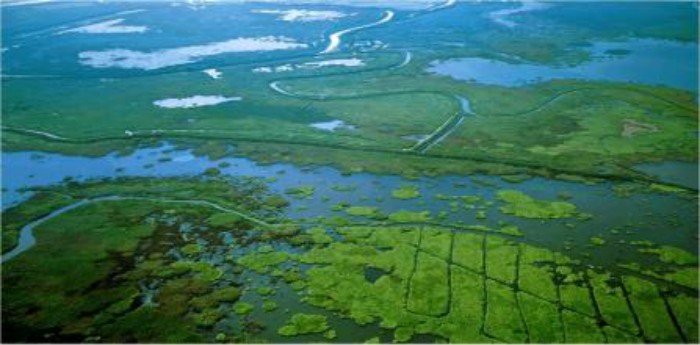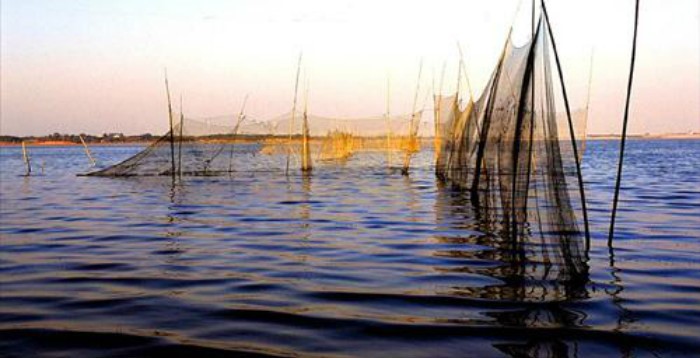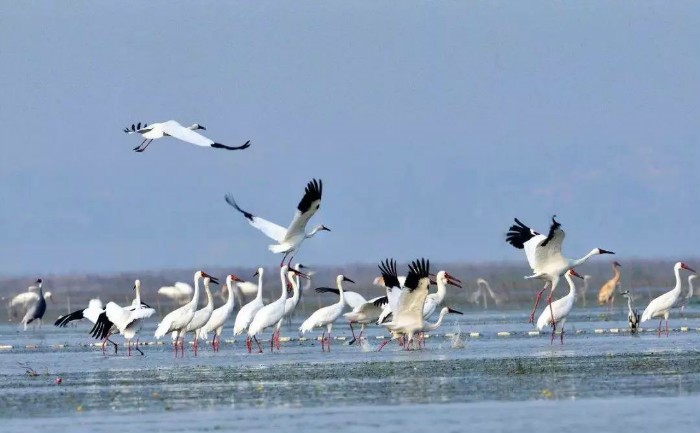Located in the Jiujiang City, Jiangxi Province, Poyang Lake is the largest fresh-water lake in China. Poyang Lake is a resplendent pearl on the vast Chinese territory. For thousands of years, it has been nurturing the people in Jiangxi Province and attracting visitors with her charm.

On days when the sun shines and the sky is a clear blue, the sky and the water seem to meet on the horizon. Sailboats on the lake dart back and forth, appearing to joust with the billowing clouds. Rafts float along one after another like a big moving dragon. In addition, many kinds of rare birds are attracted here, making it a popular destination for birdwatchers.

Dagu Hill is an island in Poyang Lake , which when seen from a distance, looks like a large shoe floating in the blue water. It is also known as Shoe Hill.
Actually Dagu Hill is only one peak with precipices on its three sides. Covered with tall, straight trees, the island rises steeply from the water, surrounded by water on all sides. Visitors who hike to the top of the hill are rewarded with a magnificent view of the vast Poyang Lake below. Along the way, you will see Heaven Flower Palace, with its majestic halls and splendid statues. In ancient times, the hill was a gathering place for scholars and businessmen. The buildings in which they met have been destroyed by wars and natural disasters, but you can still feel a strong sense of history on Dagu Hill.

Another well known hill in the lake is Nanshan Hill, near Duchang County, which rises from the water like a dignified man standing in the waves. According to the legend, during the Western Han Dynasty (206BC-24) a wise man lived on Nanshan Hill. Emperor Wudi met the man during a tour of inspection in the southern region of his territory and offered him an official government position. However the wise man turned down the offer, saying that he was just a farmer and was not interested in fame or rank. Named for the humble wise man, ‘farmer rock’ is the main attraction of Nanshan Hill. There visitors enjoy the sight of clear, sweet spring water flowing from the rock all year round. Those who climb to the top of the hill enjoy a panoramic view of the lake and distant hills.
Lake-View Pavilion was originally constructed in the later years of the Eastern Han Dynasty (317-420) and the early part of the Three Kingdoms Period (220-280). The present exquisite pavilion was rebuilt by the local government in 1988. It has four floors and stands on a platform made of granite. The view from Lake-View Pavilion takes in the rivers, the lake, the fishing boats, and the birds that contribute to the beauty of Poyang Lake.
This area is a sanctuary for many rare species of birds. Measuring 224 square kilometers (about 86 square miles) in area, it offers a mild climate and a habitat rich in aquatic plants and fish with no industrial pollution. In winter, Poyang Lake is home to the world’s largest population of birds.
Every November, thousands of birds fly in from Siberia, Mongolia, Japan, North Korea, and the northeastern and northwestern regions of China. These migratory birds spend the long winter in Poyang Lake together with the native widgeons, egrets, and mandarin ducks, leaving gradually as the weather starts to warm in March. Poyang Lake is considered by many to be the largest bird sanctuary in the world. Every winter it plays host to 95% of the world’s white cranes, a fact that gives it two of its popular names: ‘World of White Cranes’ and ‘Kingdom of Rare Birds’.
Leave a Reply